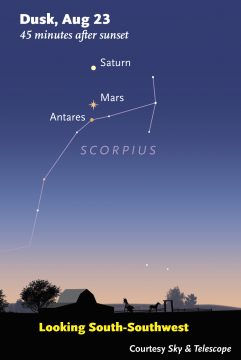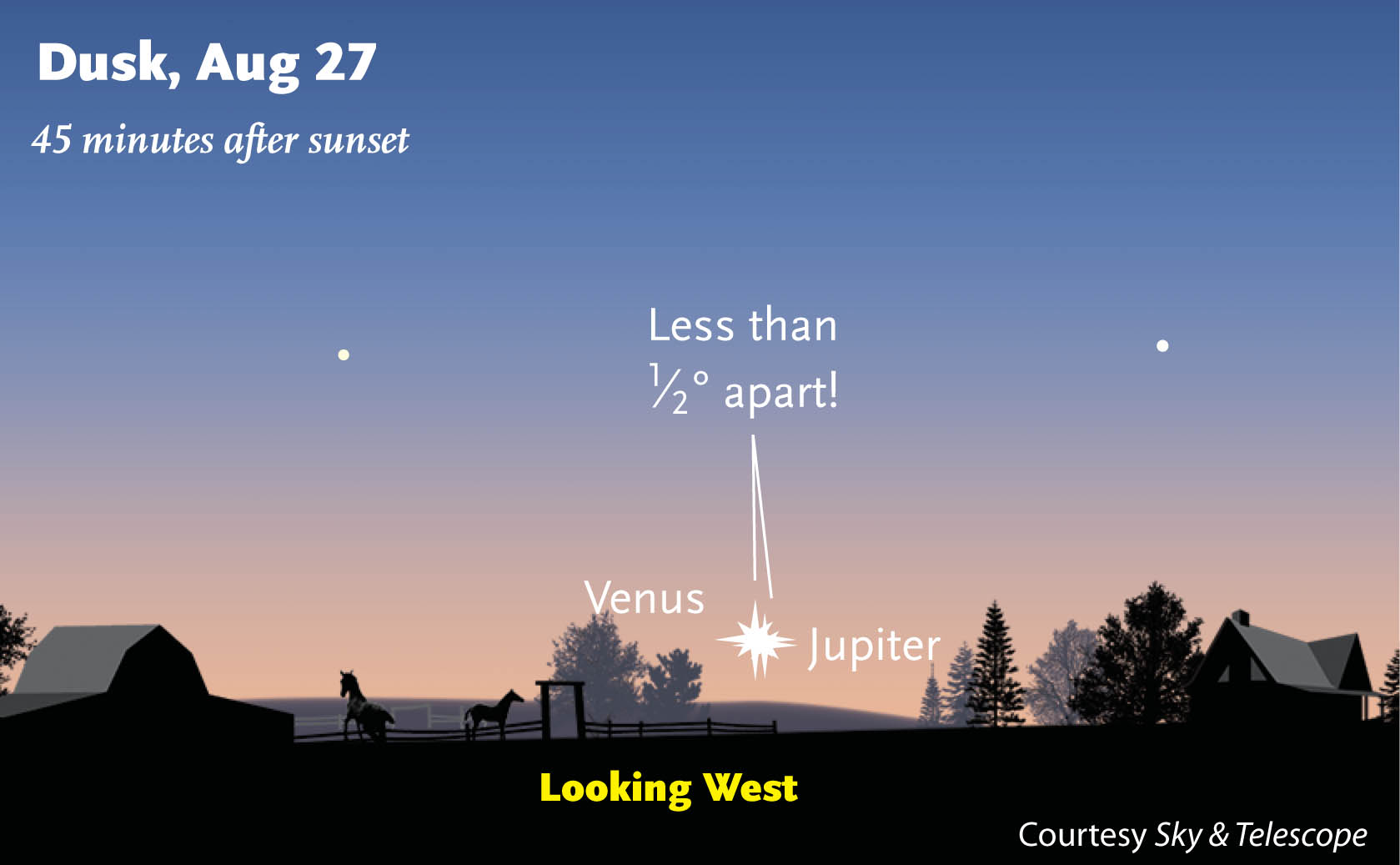Astronomy - Two Planet Pairs Perform at Dusk
As twilight fades during the rest of August, follow two planetary dances going on in different parts of the sky.

Saturn, Mars, and Antares line up almost vertically on the evening of August 23 and 24, 2016. Have a look! Sky & Telescope diagram. Click image for high-res version. (Free to reprint with the credit line "CourtesySkyandTelescope.com").
Step outside as the stars come out, look southwest, and you’ll see an eye-catching pattern. For the next few days (August 17–22), bright orange Mars shines to the right of Saturn and the reddish star Antares. The three form a tall triangle that changes every night
Mars is moving leftward on its way toward passing between the other two. On Tuesday and Wednesday August 23rd and 24th, the triangle will collapse to a nearly vertical line of three shining points.
After that, Mars will continue leftward and the triangle will widen again, pointing in the opposite direction.
Striking as they are, these three objects have nothing to do with one another. The eye-catching arrangement results from a line-of-sight alignment. Mars is the nearest, 7 light-minutes from Earth (79 million miles). Saturn is almost a dozen times farther away at 82 light-minutes (914 million miles). Antares, the lowest of the three in the sky, is about 550 light-years in the background, or 3.3 quadrillion miles into deep space.
Fainter stars of the constellation Scorpius glimmer in the area too.
Notice that, being a star, Antares is the only one of the bright three that twinkles. That’s not the star’s own doing; twinkling is caused by the slight heat waves that are always rippling through in Earth’s atmosphere, mostly within just a few miles of your eyes. Planets appear larger across from our relatively nearby viewpoint, as tiny disks rather than points, so the separate twinklings of each point on a planet’s face generally average out to a steady glow.
Venus and Jupiter Too!

Starting 20 or 20 minutes after sunset on August 27th, look low in the west for a dramatically close pairing of Venus and Jupiter. Sky & Telescope diagram. Click image for high-res version. (Free to reprint with the credit line"Courtesy SkyandTelescope.com").
Meanwhile, the two very brightest planets — Venus and Jupiter — are going through antics of their own. They’re way down low, due west, after sunset. Look for them close to the horizon, somewhat left of where the Sun went down, 20 or 30 minutes after sunset. If you have an unobstructed view and clear air, you’ll see that Venus and Jupiter are drawing closer together every evening. Venus is the lower one. If the air is hazy, binoculars will help.
By August 24th, Venus and Jupiter will appear separated by 3° — just two finger-widths at arm’s length. On the 26th, they’ll be 1° (less than one finger) apart. Then, on August 27th, they’ll have such a close conjunction — separated by only 0.1° — that you may need binoculars to see that they’re two objects, not one!
Again, looks are deceiving. The two planets merely happen to be along our same line of sight. Venus on August 27th is 13 light minutes from Earth (144 million miles), while Jupiter is four times farther: 53 light-minutes, or 592 million miles.
This is the last of a recent trio of very close conjunctions of Venus and Jupiter. The other two occurred before dawn on August 18, 2014, and on October 26, 2015.
No comments:
Post a Comment